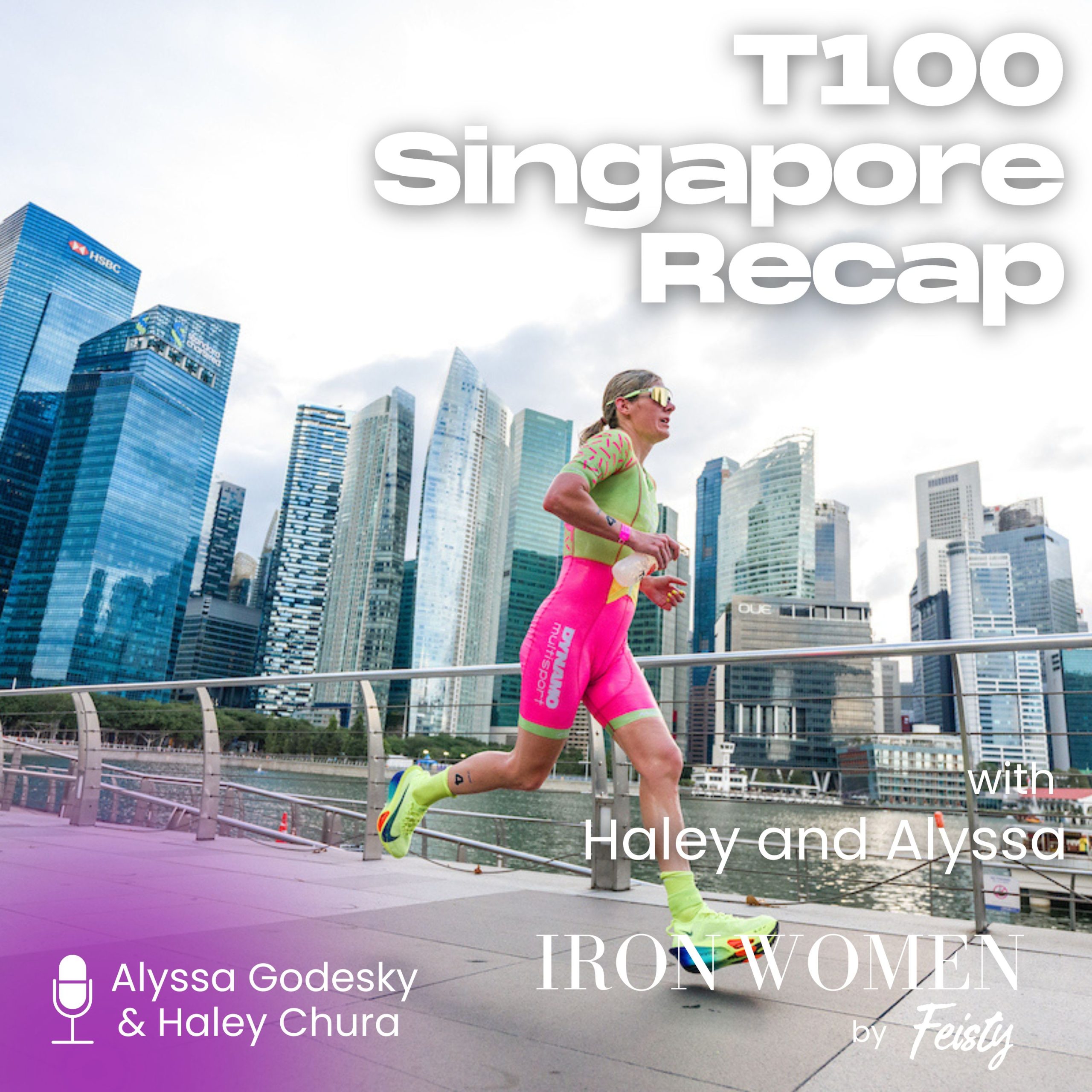July 31, 2019
Alyssa’s FKT Anniversary
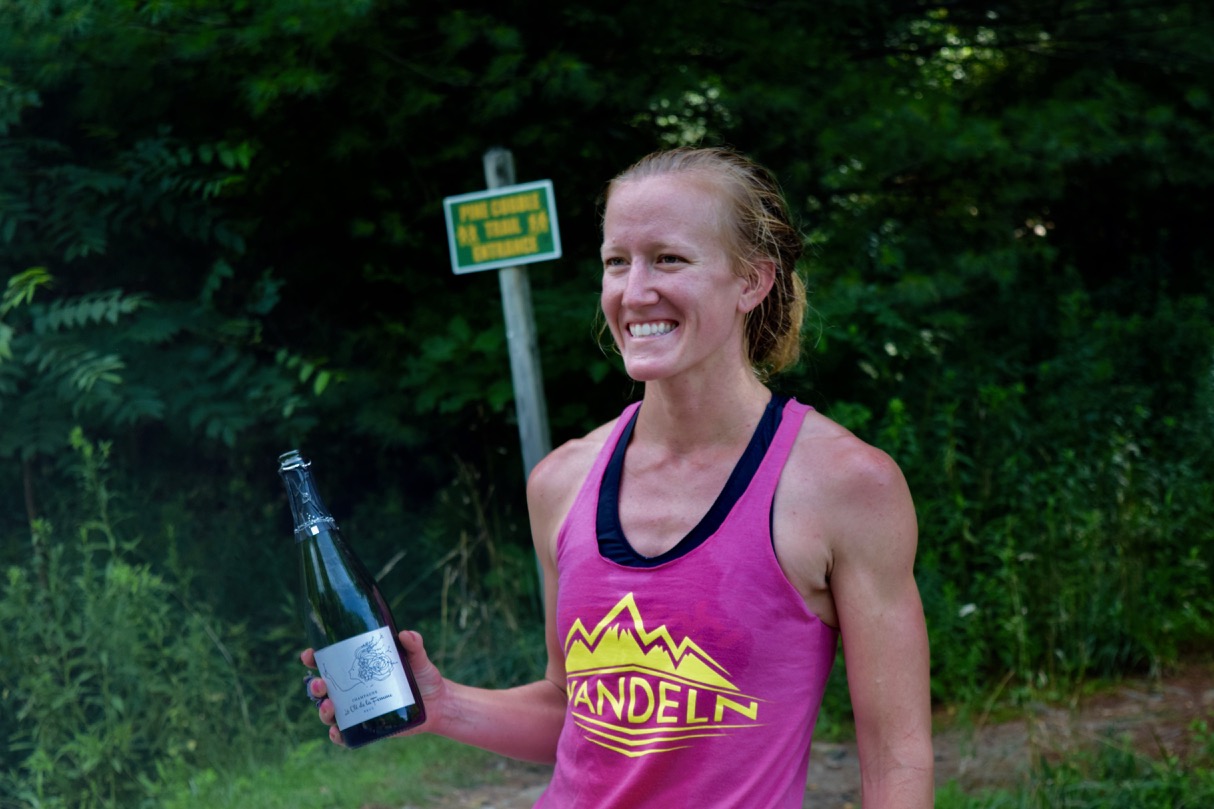
It’s so simple: just give yourself the opportunity to try as hard as you possibly can. Go all-in, invest yourself in it, and do your best. Win or lose, record or not, if you do that you will get to find out what you’re made of. And that is a totally worthwhile gift to give yourself.
-Alyssa Godesky
One year ago to the day, IronWomen podcast host and professional triathlete and coach Alyssa Godesky set a fastest known (supported) time, or FKT, on Vermont’s Long Trail. The 273-mile journey took her and her crew 5 days, 2 hours and 37 minutes. Hear stories from Alyssa and her support crew in the video (above) and read all about it (below).
by Sara Gross

SG: How did you first conceive of this crazy idea to go after the FKT on the Vermont Long Trail? And why this particular trail?
AG: In 2010 I did a multi-day race called Three Days of Syllamo, where you do ~100 miles in 3 days, and I loved it. I also did pretty well there, so I knew this sort of thing could be something I was good at. After Jennifer Pharr Davis set the overall FKT on the Appalachian Trail in 2011, I began to pay particular attention to long distance hiking and speed records. When Finding Traction [documentary which detailed Nikki Kimball’s record setting run on the Vermont Long Trail] came out it was the first real insight I had into something like this though. You know how when you reallyyyyy want to buy something online, but you’re making yourself wait and think about it, that item
is always in the back of your head? And you fight the urge, constantly putting it into your cart, then closing the tab, over and over? That’s how I felt about the Long Trail. It always sat in the back of my mind as something I really wanted to try, but the timing didn’t feel quite right until this last year.
The Long Trail was attractive to me because it is on the East Coast, and I love the rugged and technical trails that you find out east. It’s also long….but not too long! It seemed like the right length to try this out and not be in too far over my head.
SG: You called it “Project Wandeln,” what does that mean and why was it important to have a title?
AG: Last October, I went to Vermont for a week to do some recon on the trail. Honestly, after that I week, I came back home thinking I wasn’t going to do it: it was too hard. While I was out there, I didn’t run a single section close to the time I needed to for record pace, and after only about 75 miles over 6 days I was so sore I couldn’t imagine doing another 200. I thought I just wasn’t strong enough to do it. Luckily, my coach, Hillary Biscay, talked me out of that. She reminded me that a fear of failure is no reason not to do something if I really wanted to try it.
So, we put it back on the drawing board, but I knew it was going to be “a project.” This was going to be something larger than anything else I had ever taken on, and I wanted to go all-in. I felt that naming the adventure would help give it more purpose and direction, also helping to rally support that would be much needed when things got tough. I also have some ideas for adventures down the road, so I thought why not give this it’s own spirit?
I found the word wandeln as I was searching through the black hole of the internet, dictionaries and thesaurus’. Wandeln means to wander or stroll, but also to transform or change. I knew as soon as I found it that was the perfect fit.
SG: A tremendous amount of planning went into Project Wandeln. Why was planning so important?
AG: The long trail is 273 miles, with road crossings between 6-20 mile segments. I’d be running and hiking for 18-21 hours a day. We would be at the mercy of weather conditions and trail conditions. I was going to need help constantly, pretty much 24 hours a day, to make sure I was well fed, hydrated, and had access to all kinds of clothes, shoes and socks along the way. Oh, and, my crew would be rotating through pacing the sections so I’d never be on my own….and they would have their own needs of fuelling and hydration to think about. We’d also need places to sleep for myself and the crew along the route approximately where I’d be ending up each night.
Are you exhausted thinking about it yet? This really only scrapes the surface of all the layers to think about when you deep-dive into something like this. So starting the planning early was very important, giving us time while I was in Vermont (the two months leading up to the run) to fine tune the local details and the things we couldn’t plan until I was there in person.

SG: Where did you sleep?
AG: The first night went according to plan: one of my crew members, Kurt, hiked in ~3 miles to a shelter on the trail. He reserved some space in the shelter with sleeping mats and bags for me and Matt who would be pacing me through the night. The shelter ended up being full, so it was really great he did that to get us a good spot to sleep since we only had 4 hours to make that sleep count!
On night two, we were a little behind projections and it was storming, so Matt (also pacing me through night two) and I had to sleep in the back of my car (an FJ cruiser) with the sleeping mats and bags. It wasn’t ideal, but it worked!
Night three was when I was starting to feel the lack of sleep start to add up, so my crew arranged for a hotel room for me that was about ten minutes off the trail. It was a long night in the woods to get there, and I still have no clue what the name of the hotel was or what room we were in, but there was the most comfortable twin bed I’ve ever slept in in my life! While it was comfortable, we still didn’t let me get TOO comfortable – 4 hours and we were back out on the trail.
My last night of real sleep was again in the back of my car. This time the weather was cooperating though, so we could leave the back door open, hang some mosquito netting, and blow up a big air mattress — talk about luxury! It felt extra luxurious as Will was sleeping on a mat on the ground next to the car, and Matt was in a hammock nearby.
My last overnight was the push for the finish and quite honestly I didn’t have time for another long sleep. Will and Carly did hike in a sleeping bag for me where I slept for 1 hour at a shelter on the top of a mountain. It would have been pretty romantic if my nose wasn’t bleeding and if the hiker next to me wasn’t crinkling his granola bar wrappers for an hour! To be fair, it was only 7pm so definitely not “quiet hours” yet.
I also took a 30 minute nap in the back of the FJ with 14 miles to go. I’m pretty sure I just crawled in and slept on top of all sorts of stuff back there. Then, with about 8 miles to go, I took a nap in a fern bush while Matt and Emily repaired my blisters. Yes, you read that right!
SG: What did you eat?
AG: My plan for eating was to be strict about trying to consume ~300 calories an hour, but somewhat relaxed about how I got those in….I wanted to listen to my body and eat what it felt like along the way.
My main source of calories was F2C Nutrition’s Endurance 5:1 (a product that mixes into water and is a carb-protein ratio of 5:1). This worked like a charm! My crew was surprised that for the entire 122 hours I happily downed flask after flask of F2C. Because that was going down so well and keeping me feeling good, I didn’t end up needing to eat very much solid food elsewhere. When I did, pizza rolls, ramen soup and pop tarts were my first choice. I also enjoyed some slim jims, snickers bars, Swedish fish, pierogies, tater tots and fried chicken.
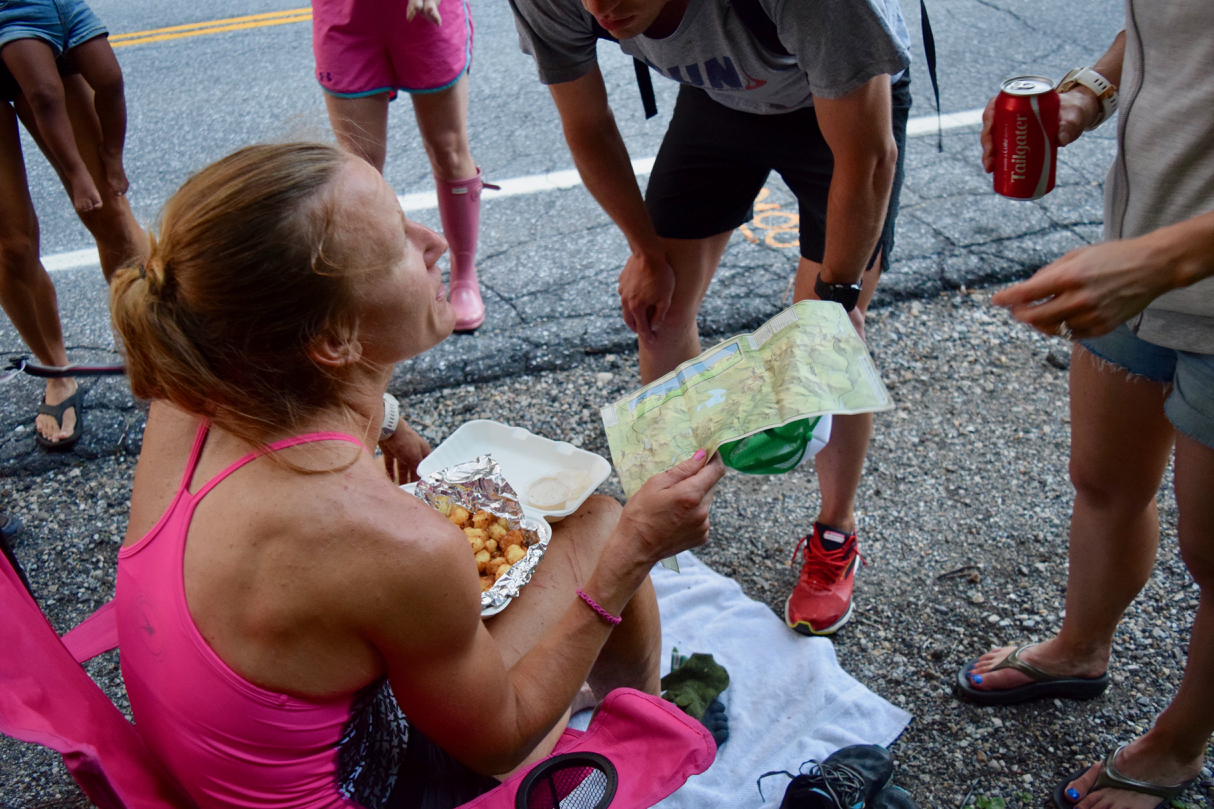
SG: How did you choose your crew and what were their jobs?
AG: My crew, my amazing crew!!!! I started chatting with friends about this about a year ago. I wanted to mention it was in the works and have people mark off the date in case it did come to fruition. But, asking adults with jobs and families to take over a week off to spend in the woods living out of cars is a HUGE ask, and so it wasn’t until May that we were able to really firm up who was going to be able (and willing!) to come along. Matt, Hillary, Maik, Will, Leslie, Emily, Carly, Michele, Lyssie Cat, Kurt, and Sara….they were so selfless and the most phenomenal crew I could have ultimately had. We did’t divvy up jobs too much — for the first couple days we had outlined who our main drivers were, as well as the main pacers. But we knew that planning too much for after day three would be a little pointless because we had to just see how things play out. As for crew duties at each aid station….I have no clue how they figured that out! All I know is that when I arrived to each checkpoint, they had everything I needed, every time: shoes, socks, food, hydration, a chair, a towel and smiles….I can’t say enough times how this would not have been possible without them!
SG: What was the hardest part?
AG: The sleep deprivation! I’m so trained that when things aren’t feeling good or going right that it’s a calories thing: eat something, drink something, and I’ll come around. I wish that would have fixed how sleepy I had been getting. It was almost like being super drunk, and having to follow a really technical trails. It’s really, really hard, and your mind can only think about the one thing it wants so much: sleep!
SG: Related: Did you want to quit? When? and how did you stop yourself?
AG: Night three was tough – really tough. I hadn’t seen that section of trail before, and we were doing it in the dark with some bad weather. It seemed endless, and I definitely let myself get into a tough mental place a few times where the entire thing seemed pointless. Luckily, Matt and Carly were with me to keep me putting one foot in front of the other and get me to the end of the section, and ultimately, a bed….I felt like a new human after some sleep.
After that, I didn’t necessarily want to quit the whole thing, but I did have many moments of feeling like I just wasn’t going to be able to make it. The latter part of the trail has many long sections of 15-20 miles at a time, so you aren’t seeing a crew as much to perk you up. And I was SO SLEEPY that all I wanted was sleep. That would have been a very slippery slope, because the amount of sleep I wanted/needed at that point would have caused me to lose the record. I had fallen pretty helpless to that desire though, so without my crew to keep going, it could have ended without getting the record.
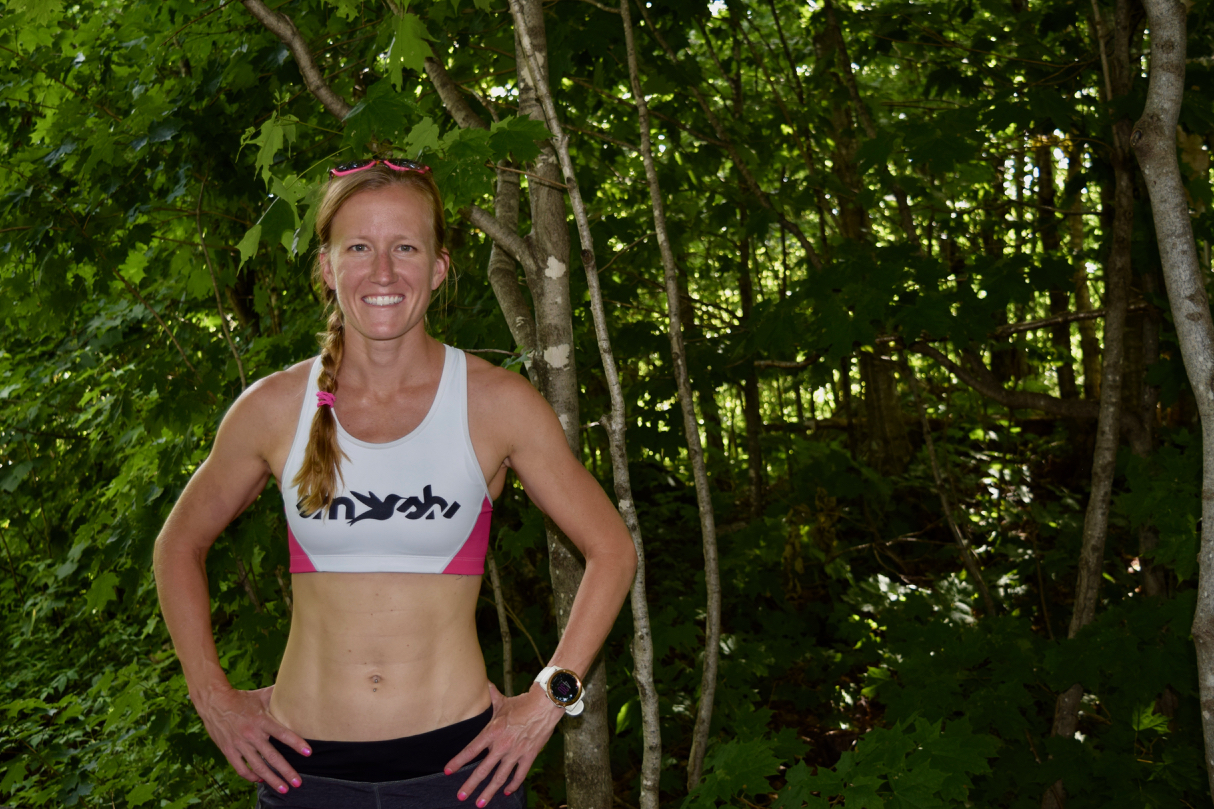
SG: You said that mental toughness can be trained. what do you mean by that and how can we train it?
AG: I find that you can always raise the bar. I often think in training “man that was the hardest thing I’ve ever done” — sometimes about one workout, sometimes about a weekend, sometimes about a week’s load of workouts. And then I go to bed, wake up, take a look at the training for the day or week ahead and it’s just a little bit tougher. Or maybe it’s exactly the same, but now I have to execute when I’m that much more tired.
Those layers of day over day, week over week – and most importantly I think – year over year – of consistent, challenging training is what develops mental toughness. You can’t help but learn little tricks along the way to get you through tough times. Whether it is a mantra, or a fuelling strategy, or simply getting used to your body feeling uncomfortable, those all become tools in your tool belt that you can draw on when things are tough. In the seven years I have been working with Hillary, she has challenged me in ways I can’t even describe. From ultramarathons, to back-to-back weeks of ironman racing, to racing six Ironmans in a season…the physical training has always been a challenge, but it was also really mentally tough to string seven seasons of that together. But every bit of that added up to give me the strength to face this particular five day challenge.
SG: How long did it take to recover?
AG: Honestly, I was blissfully unaware of how tough this recovery would be. I remember some painful recovery days after running 100 milers, but this has been next level, and in ways I didn’t expect! I thought my body would be really beat up, but I think since the pace of the days wasn’t too fast, my muscles were holding up really well. My feet were another story! They held up beautifully for about 4 days, but the last day or so of really wet and muddy trail conditions changed that.
I am also used to some massive cankles after racing….this time I was introduced to what I have found is the “thankle”….my entire legs were so swollen, even my knees disappeared! They would get a bit better, but any walking or sitting would bring them back in 20-30 minutes. So, I spent the good part of the days after with my legs propped up.
I had some pretty big blisters on my heels and toes, but those cleared up well, with the exception of the one on my big toe. I caught it before the infection got too bad, but it did require a doctor’s visit, drilling some holes into the toenail, and now we keep our fingers crossed I eventually get a new toenail on that foot. Exciting times!
I was also unprepared for the mental aspect of recovery. For 3-4 days after, I was only able to sleep for about 90 minutes-2 hours at a time, and would often wake up panicked that I needed to keep hiking. I was having very vivid dreams about the trail, and even some hallucinations about still hiking when I would wake up in the night. The sleep part eventually started getting better (think really, really bad jetlag!) and as I was able to sleep longer, the nightmares also subsided. But I have never experienced anything like that after racing!
SG: It’s been a year since you set the record, if you could speak directly to women and girls who are thinking of taking on a huge challenge what would you tell them??
AG: I would remind them that this entire thing was something I was ready to quit before I even started it because I thought it was too hard. I was haunted by these memories I had of races 9 years ago, when Nikki Kimball (the previous record holder) and I had raced the same races. In one, I didn’t finish (she won!), and the other she beat me by 8 hours. It was so easy to fall into these thoughts that I just wasn’t the runner that she was and I had no business trying to get this record. Imagine if I had let those win? I would have never had this amazing experience. You just never know, so you have to try. It’s so simple: just give yourself the opportunity to try as hard as you possibly can. Go all-in, invest yourself in it, and do your best. Win or lose, record or not, if you do that you will get to find out what you’re made of. And that is a totally worthwhile gift to give yourself.
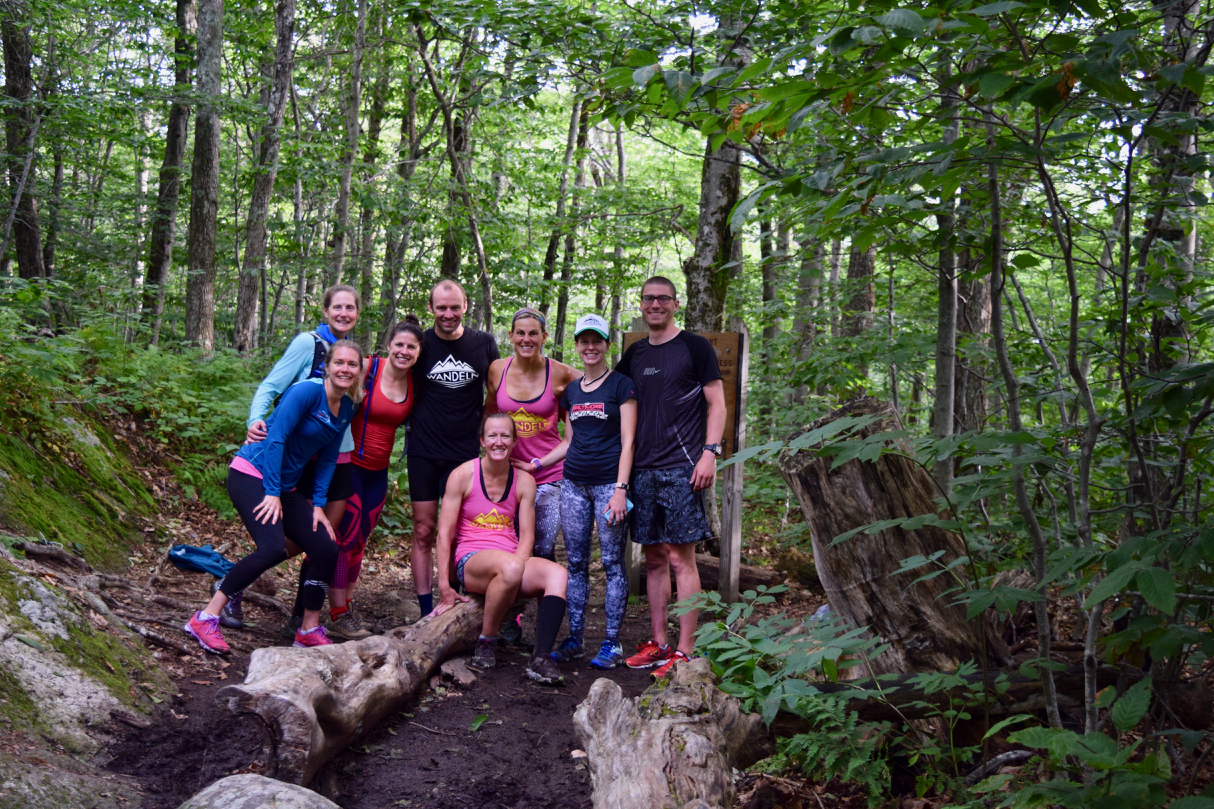


 Outspoken Women in Triathlon Summit Returns Bigger than Ever
Outspoken Women in Triathlon Summit Returns Bigger than Ever  Driving the Lamborghini: Productivity and the Power of Paper
Driving the Lamborghini: Productivity and the Power of Paper  5 take aways from the Compete Sports Diversity Summit
5 take aways from the Compete Sports Diversity Summit  Simple Tips to Hone Your Bike Handling Skills
Simple Tips to Hone Your Bike Handling Skills 